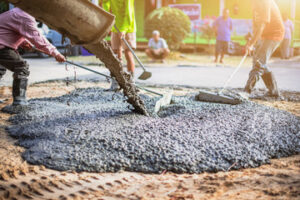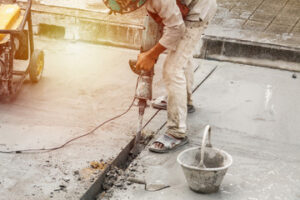Concrete Columbus OH is a sturdy construction material that is used for various large-scale projects, including roads and commercial parking lots. It can withstand heavy traffic and harsh weather conditions.

Concrete requires a precise mix of water, Portland cement, and aggregates in order to function properly. It is important to understand what each component is and how it works.
Concrete is a composite material that is made by mixing aggregates (such as sand, gravel or rock), a binding agent like cement and water in specific proportions. The strength of the final product depends on how well all these elements are mixed together. For instance, too little cement will not fill the voids between the aggregates and too much will lead to cracking. To avoid this, the cement, aggregate and water must be measured and added in precise proportions.
The hydration process is an exothermic reaction that starts immediately after mixing, and this is the moment when concrete begins to build its strength. This reaction is accelerated by the use of steam or hot water, which is also why a water-to-cement ratio is critical in concrete.
While concrete is incredibly strong and can hold immense loads, it is not indestructible. Over time, concrete can be affected by thermal movement and water evaporation, which leads to shrinkage. The resulting stress can cause the concrete to crack, exposing internal steel reinforcements and potentially causing structural failure. This is why it is important to monitor the concrete for signs of cracking and take steps to prevent damage if necessary.
Another concern is the fact that concrete is often exposed to harmful chemicals, such as de-icing salts, which can corrode the steel reinforcing bars used in its construction. This deterioration can lead to surface scaling, spalling and, in severe cases, complete structural failure. To avoid this, concrete must be protected against chemical attack with the help of corrosion-resistant coatings or reinforcements.
There are many different types of concrete, with each designed to meet the needs of a particular project or environment. For example, type S rapid-set concrete can achieve early strength, which allows supports or formwork to be removed earlier than conventional concrete and helps reduce construction time. In addition, type MH concrete is designed to be sulfate-resistant and can be used in soil with moderate amounts of sulfate. In general, concrete is a durable and versatile building material that can be used in a wide range of applications.
Durability
The durability of concrete is an essential part of its use as a construction material. The structures built with it must be able to resist damage from external attacks, like chemical or physical deterioration, and other environmental factors that can reduce its useful life. Insufficient durability can lead to additional costs for repairs and reconstructions that can significantly impact a project’s timeline and budget.
The history of the Silver Bridge catastrophe is a sobering reminder of the importance of meticulous engineering, quality materials, and regular maintenance in ensuring the longevity and safety of concrete structures. The lessons learned from this tragedy continue to inspire innovations in concrete design and fabrication.
Concrete is a highly durable material that can withstand significant amounts of pressure and weight, making it an excellent choice for buildings or infrastructure that must stand up to heavy traffic or weather conditions. It also resists damage from freezing temperatures, thawing cycles, and deicing chemicals. Additionally, the watertight properties of concrete make it ideal for use in areas with frequent flooding or harsh weather conditions.
Aside from its innate strength, the durability of concrete is further enhanced by the inclusion of certain additives and materials. The use of super-plasticizing admixtures can help to control shrinkage and cracking, thereby extending the service life of concrete. Other useful admixtures include fly ash, blast furnace slag, and silica fume.
Using the right mix proportions is also important for achieving the desired level of durability. An imbalance between the water-cement ratio and cement content can cause a reduction in concrete porosity, leading to lower strength; while too little water can prevent proper hydration and skeletonization. Adequate curing practices are also crucial to concrete durability. Curing concrete for a period of at least 7 days is the standard practice, but shorter periods may cause severe reductions in durability.
The durability of concrete is also affected by the type of aggregate used, the sulfate resistance, and the alkali aggregate reaction (AAR). Achieving these characteristics can increase the service life of concrete up to ten times. Additionally, longer service lives can reduce annualised embodied impacts and the environmental impact of construction projects.
Reliability
Concrete is a versatile construction material that can be used in all sorts of buildings. Its strength and durability make it ideal for a variety of applications, from residential buildings to airports and railway stations. It is also commonly used in roads and bridges. It is also useful for paving and drainage systems, as well as in tunnels and water tanks. Concrete is a highly durable material that can withstand many conditions, including fire and water. However, it can be vulnerable to damage from impact and vibration. To avoid this, it is important to maintain concrete structures. Regular inspections and maintenance are vital in preventing corrosion, which can cause structural damage and safety hazards. In addition, the concrete must be properly reinforced to prevent damage. The failure of a concrete structure can have serious consequences for the people who use or occupy it. The structure may be dangerous or unsafe, or it could collapse and fall into the surrounding area. To minimize the risk of damage, engineers use a range of methods to assess the integrity of concrete structures. These include destructive and non-destructive testing.
The reliability of a concrete structure can be determined by using a number of tools, including the allowable complementary strain energy and the reliability index. These two variables represent the maximum allowed plastic damage to the concrete and steel respectively. The allowable complementary strain energy is based on the structural parameters of a concrete sample, which are usually deterministically evaluated. The allowable complementary strain energy is then compared to the actual load (F) of the concrete structure to determine its performance.
A new approach to determining the reliability of concrete is being developed by researchers at MIT. It uses a Bayesian workflow to model the uncertainty in the compressive strength of a concrete structure based on both destructive and non-destructive tests. The approach is a step up from existing methods, which rely on an infinite weakest-link model.
The method combines mesoscale heterogeneous fracture modeling with state-of-the-art machine learning. It has the potential to provide a more accurate and efficient analysis of pitting corrosion in FRP-confined concrete, especially when the corrosion process is not uniform around the steel reinforcement. This can help in predicting the serviceability of a concrete structure, allowing engineers to better predict maintenance requirements.
Customization
Concrete is a versatile construction material that can be customized to suit a variety of purposes. It can be molded into shapes and forms to create unique architectural designs, or it can be stained or polished to enhance its aesthetic appeal. It is also a very durable and cost-effective material, making it an excellent choice for commercial buildings.
There are many different types of concrete, each with its own unique properties and uses. Some are designed to be stronger than others, and some are better suited for certain environments. For example, pervious concrete is used in paving projects because it allows water to pass through it, while dense-strength concrete is used in foundations and other structural applications that require high-strength materials.
The type of concrete used in a project can depend on a number of factors, including its durability, strength, permeability, and cost. In addition, the concrete can be colored to create a specific look or to match other construction materials. The color of concrete can affect its visual appeal, as well as the mood and atmosphere of a space.
For residential construction, concrete is an extremely popular building material. It is used to create foundations, walls, and floors, and it offers a sturdy and secure base for homes. Additionally, concrete offers superior thermal insulation, which can help reduce energy costs.
Concrete can also be shaped and stamped to create distinctive design elements, such as patterns and colors. It is also easy to work with, making it a great material for DIY projects. However, it is important to follow simple safety precautions when working with concrete.
Another way to make concrete more environmentally friendly is by using recycled glass as aggregates. This method of incorporating recycled materials into concrete can increase its durability and improve its aesthetics. It can even be molded into decorative shapes to complement the surrounding environment.
Concrete is an essential part of the global infrastructure, from dams and flood barriers that protect communities from natural disasters to water pipes and storage tanks that provide safe drinking water. It is one of the most widely used manufactured materials in the world, but it is not without its problems. For instance, it is responsible for 8% of the global carbon emissions and is a major source of air pollution in developing countries. To reduce its environmental impact, it is necessary to develop new construction techniques that use less concrete and cement.
